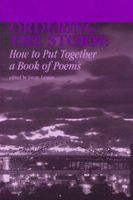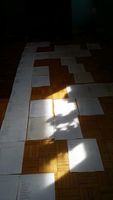Ordering a Poetry Manuscript
By Jennifer LoveGrove
There are a lot of steps to writing and publishing a book of poetry, well beyond the obvious writing of the poems. You have to be able to describe your manuscript (for grant applications and submissions), find a publisher (unless you choose to DIY), cajole other writers into blurbing it for you (no one likes this), edit the poems (my favourite part), and then arrange the poems into some sort of order. How do you decide on the sequencing of your manuscript?
Ordering a manuscript can be challenging. There are several different approaches you can take, each with strengths and drawbacks. Depending on the book, I’ve used various methods to create an order for my own work. For my first two poetry collections (The Dagger Between Her Teeth and I Should Never Have Fired the Sentinel), I approached the order similarly, but in my most recent collection, Beautiful Children with Pet Foxes, it was quite different from the first two.
The way your order the poems in your manuscript will significantly affect and inform the way the reader will experience your book. Think about how you want to be read; what kind of experience do you want the reader to have? How do the poems relate to each other? What sorts of themes and images recur? Is there any sort of narrative or sequence within how the distinct poems fit together? What sort of pace do you want the book to have?
These can be tricky questions, and more challenging still when you’re under a deadline and are focused on editing your poems and whipping your manuscript into shape for an editor, let alone finalizing the order in which they appear. So what are some of the options?
Sections. This is a popular one, and it’s the system I used in my first two poetry collections. I had linked poems that shared a topic (female pirates Anne Bonny and Mary Read, a fake plastic surgeon La Doctora, Adam’s mythic first wife Lilith), so I grouped them together. You could also group together poems that share a certain style or tone or tempo or form. I enjoyed creating titles and choosing epigraphs for each section, and thought that the reader would prefer reading all the related poems together, then moving on to a different set of concerns in the next section. As a reader, I like sections, for the most part. I like knowing where I am. But I also like surprises. I like being challenged by a book, and the reward that brings. I value being stabilized by poetry, and sectioning can be… a little too stable. A little too easy. It also invites unintended comparison. Having your poetry book in sections makes it very easy for a reviewer or critic to asses it by comparing sections. “The first section was better than the third section” or “The section in the middle sagged” and so on. Definitely that happened with my two sectioned collections. Some reviews stopped at what section was better (they never preferred the same section, either) and didn’t go deeper than that.
You could also arrange them chronologically in the order that your wrote them. This technique may be harder than it sounds – do you base that on when you started a poem, or when you finished it? Those two moments can be vastly different. If you go this route, then the reader can experience your progression, how your ideas or style or themes changed and evolved over time. This is certainly a good choice for a “selected” volume. I’m not sure it works well otherwise, though.
For my new collection, I chose not to section, but at first I was unsure what to do instead. A chronology would definitely not have worked, and while I had related work that could comprise one section, I didn’t really have solid other sections anyway. And I didn’t want it in sections, that would have made the book very uneven in tone and weird for the reader. Instead I thought a lot about pacing, about the intensity of some poems and the demands I was placing upon the reader, and how to organize that.
The core of the book is a dozen or so seemingly-unrelated poems, using different personas and points of view, that all examine a particularly difficult set of experiences in my life. Clustering them all together would have been too intense and exhausting for the reader and I think individual poems would have lost power that way. So I used these poems as anchors, and set about arranging the other poems around them in a way that allowed the related poems to loop throughout the collection, referring back to each other.
Beginning this process of creating an order was hard. It was one of the most challenging parts of making Beautiful Children with Pet Foxes. I got an anthology of essays about ordering poetry manuscripts, called Ordering the Storm, from the library. I solicited advice on Facebook. Some suggested spreading all the poems out on the floor and looking at them and moving them about and figuring it out that way. When the dog was out (my dog Edgar would have been far too interested in napping on them), I tried this approach. It was actually quite helpful; the experience of seeing them visually and sort of simultaneously worked, and once I made a few decisions about which poems to group in proximity to one another, the next choices became easier.
I thought about breathing space within the book, about white space on the page, about breaks. I have a series of poems in the book that are based on dream interpretations, and while at times dark (a dream about a miscarriage, about a possessed piano stool, about a pickup truck full of dead frat boys), they’re kind of playful at the same time. I used them as “breaks.” I interspersed them after tougher poems as a sort of breather.
Your CanLit News
Subscribe to Open Book’s newsletter to get local book events, literary content, writing tips, and more in your inbox
Then I ended up almost accidentally with a series of self-portraits. Another bunch of poems became part of a series called “Incident Report.” I began to enjoy how these related poems would periodically recur and echo back to each other, how these different thematic threads would weave together over the course of eighty pages. As I indentified linked or series of poems, I wove them around each other and before long, I had a sequence.
There must be other many other aesthetic and conceptual choices for ordering poetry books. I haven’t had too many conversations with other poets about this process. Maybe there should be an anthology on ordering poetry collections similar to Ordering the Storm, but by contemporary Canadian poets. I can’t be the only one out there who’d like to know what other writers do. Who’s in?
The views expressed in the Writer-in-Residence blogs are those held by the authors and do not necessarily reflect the views of Open Book.
Jennifer LoveGrove's latest book is the poetry collection Beautiful Children with Pet Foxes (BookThug). She is also the author of the Giller Prize–longlisted novel Watch How We Walk, as well as two other poetry collections: I Should Never Have Fired the Sentinel and The Dagger Between Her Teeth. In 2010, LoveGrove was nominated for the K.M. Hunter Artist Award for Literature and in 2015, her poetry was shortlisted for the Lit POP Awards. Her writing has appeared in numerous publications across North America. She divides her time between downtown Toronto and rural Ontario.



